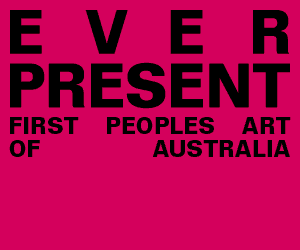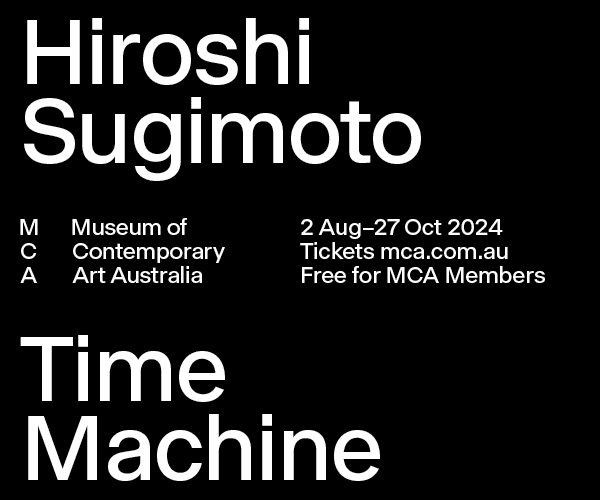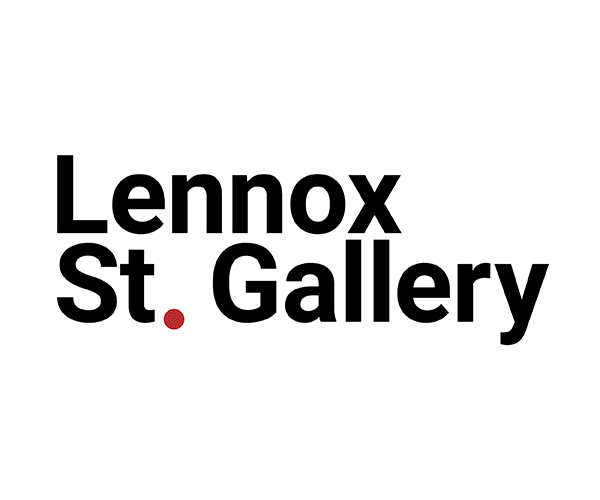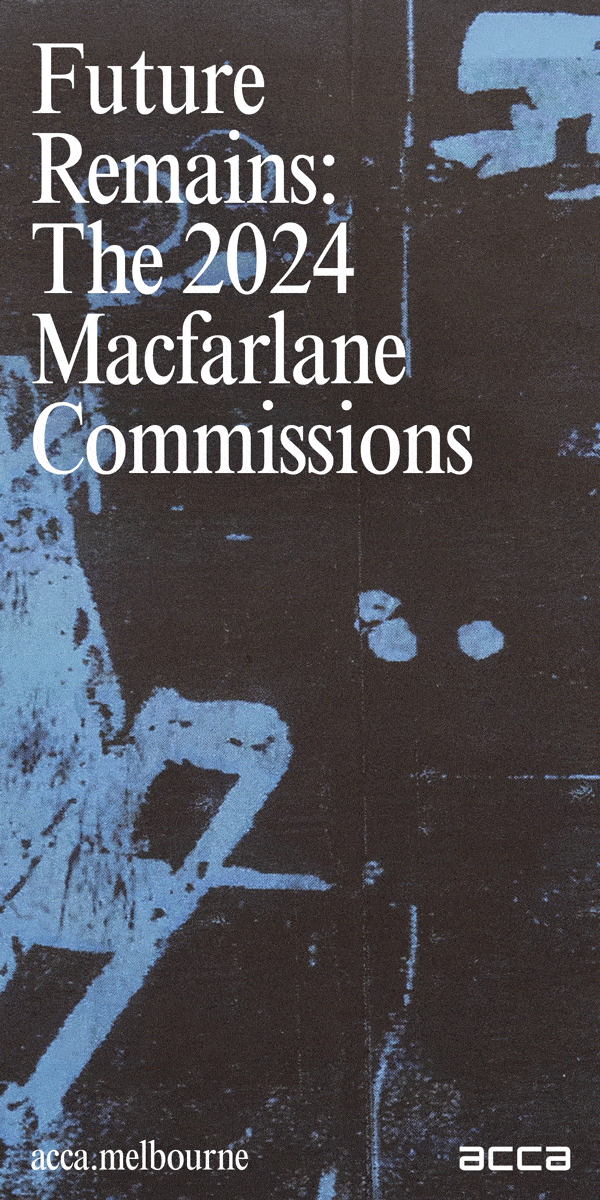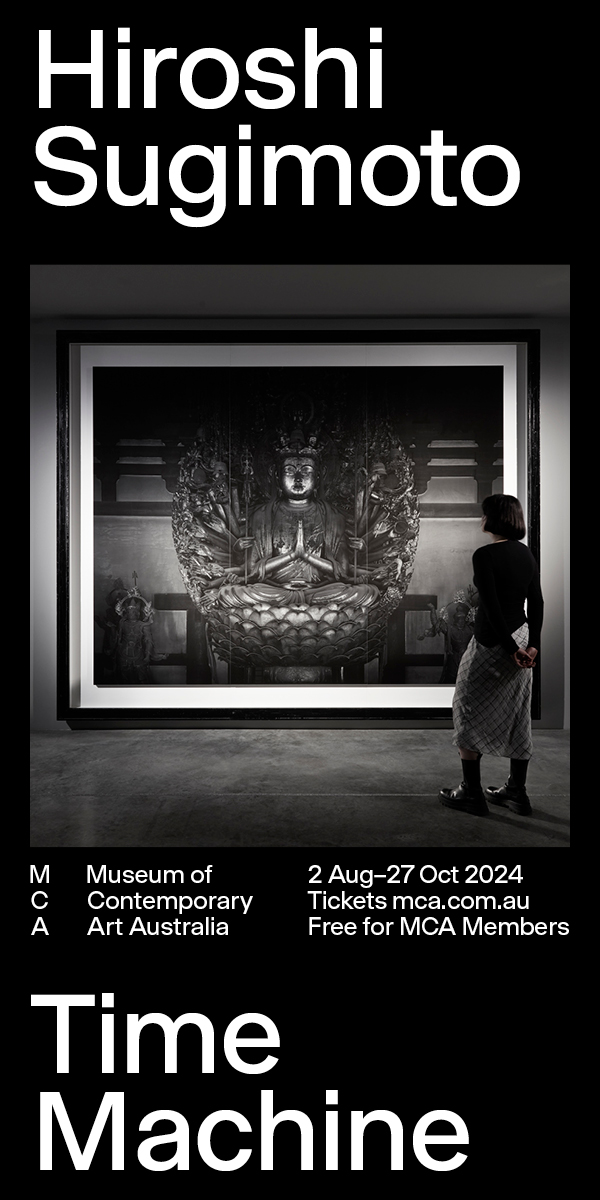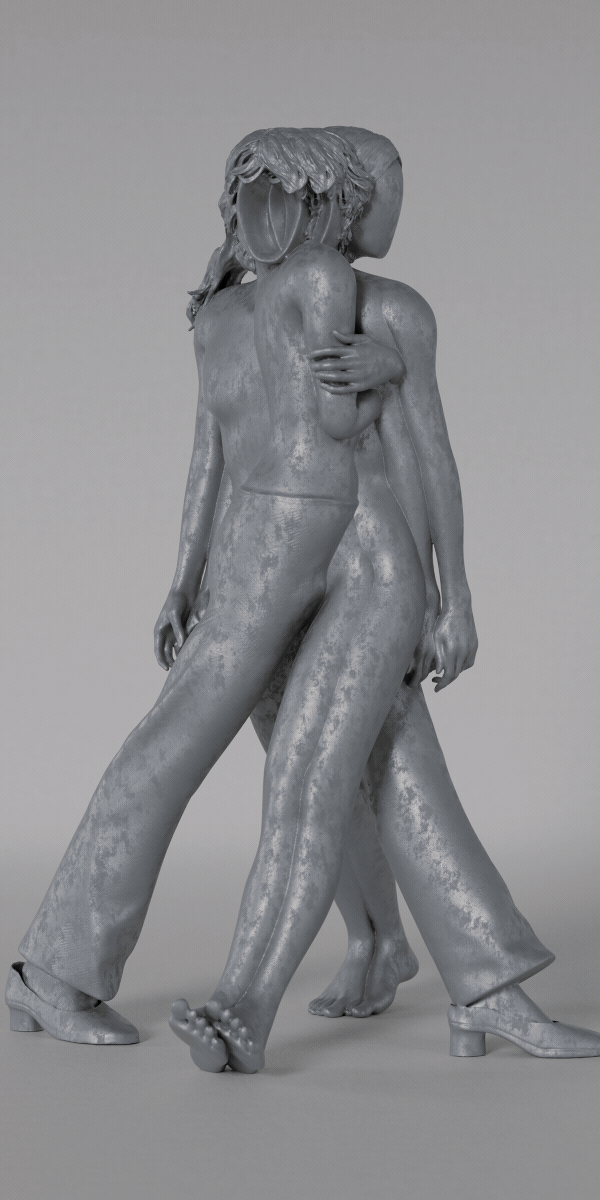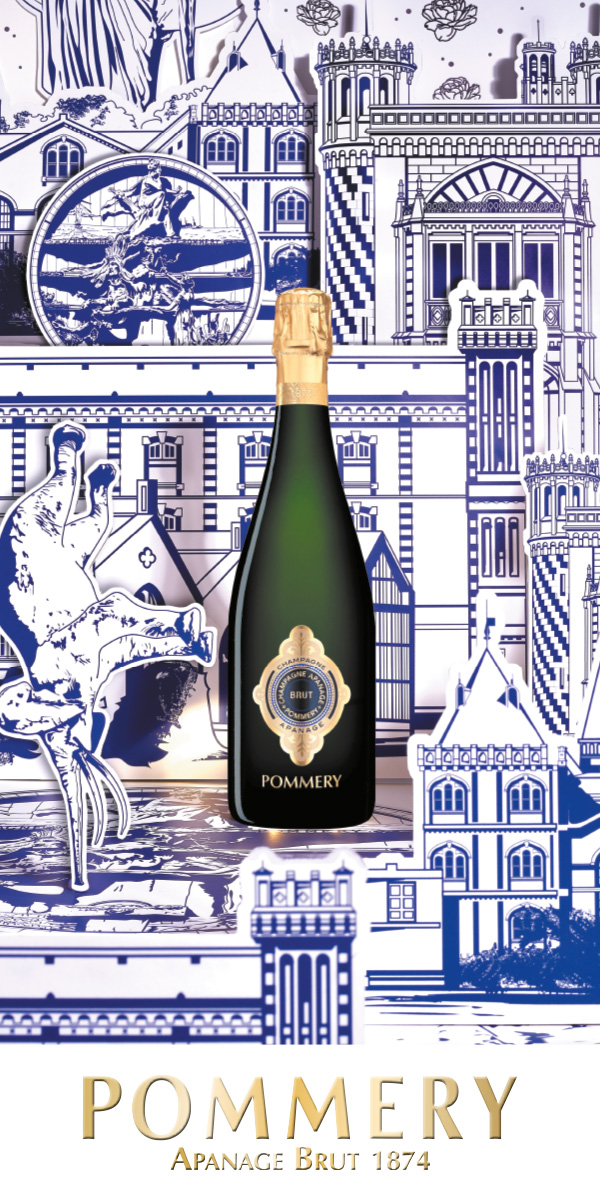Kim Gordon: Glitter and Noise
Kim Gordon is a reluctant icon, a rock legend and a feminist artist. Gordon spoke to VAULT about her friendship with Dan Graham, the virtues of Los Angeles over New York and the changing art world ahead of two exclusive exhibitions of her work at Brisbane Powerhouse as part of ΩHM Festival of Other Music 2024, curated by Lawrence English.
Object Of Projection is a survey exhibition that revisits Gordon’s previous installations, performances, video and mixed media works. Proposal For A Dance is a triptych video installation in which two female performers wield electric guitars, wearing Rodarte dresses to create a cacophony of noise in an expression of anti-pop ideals and their implications for the female body.
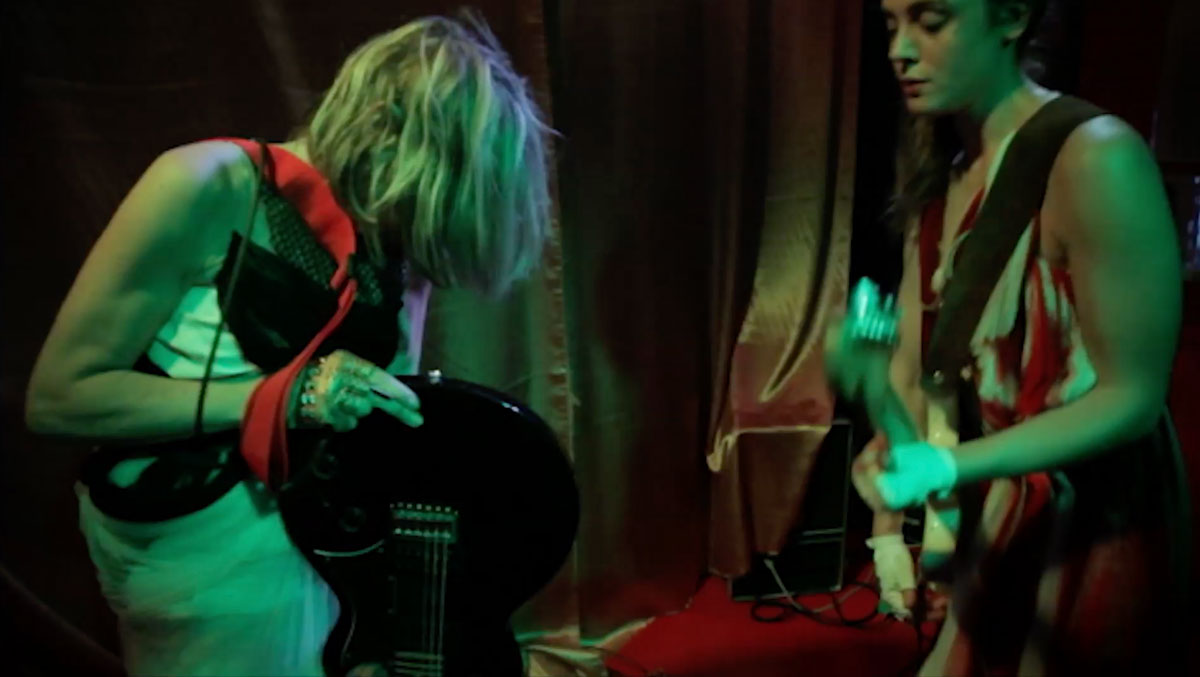
Image credit: Kim Gordon, Proposal For A Dance (still), 2012, DVD, 12 minutes. Courtesy the artist and 303 Gallery, New York
Kim Gordon, it’s such an honour to chat with you. I am very excited that your work is coming to the Powerhouse in Brisbane. Can give a little insight into the two shows, Object Of Projection and Proposal For A Dance?
Proposal For A Dance (2012) is an installation comprising three streaming screen projections. It was done in a very, very small bar club in Berlin with my niece, who’s a dancer. I brought her one of those bridesmaid dresses that are ‘princess’. We each had an electric guitar and a distortion box, and I told her to move without trying to dance and to make sounds out of the guitar without trying to play it. She had never played a guitar or picked up a guitar, [so] it’s just this cacophony of movement. And the club was really crowded. I wanted to recreate this total sense of claustrophobic sensory overload.
There are three [similar works] that I did with Manuela Dalle as a co-director. The first one (Los Angeles, June 6, 2019) was in downtown Los Angeles with me wielding a small amp that you don’t really see, going outdoors and just rubbing it on buildings as a mode of reclaiming what I identify as corporate structures, as male corporate structures. And then there was one I did in my house based on the film Jeanne Dielman, 23, quai du Commerce, 1080 Bruxelles (1975) by Chantal Akerman. I have a guitar that’s like an extension of my body, but I’m not playing it or anything. I’m just doing domestic chores in real time and the guitar is hitting things as I move around. The camera is very static, as it was in Jeanne Dielman. The last one, 12341 Brandford St, Sun Valley (2021), is in a junkyard of demolished cars using metal; again, the guitar is just part of my body.
I know it’s a cliché, but I think for a lot of people the image they have of Kim Gordon is you doing domestic chores with a guitar! I’m interested to know how your work has changed since the 1980s. Aficionados of your work will know that you come from a visual arts school background. Can you see an evolution, or has it been a seamless thread punctuated by a band (Sonic Youth), and now the work you are making?
Well, my work was a bit more conceptual in the beginning, but as I started playing music I think my visual art became more performative – a sense of having traces of the body but not showing the body in the work.
That long feminist trajectory of performative art that your work seems so intrinsically connected to.
Yeah, I didn’t really intend it like that, but as a performer I am very aware of the body in space. There’s a glitter circle being shown in the Powerhouse show (Glitter Circle, 2024), and it’s lit up so the glitter shines hopefully. And the circumference of the circle is my arm span, if I was on stage spinning around. That’s what I mean by traces of the body.
I know you’ve spoken before about Dan Graham before, but I wonder if you could talk a little bit about the impact of that relationship on you as an artist and a performer.
Well, he always encouraged me … I met him in LA, but I looked him up when I moved to New York and he took me around to different clubs and alternative spaces that were having concerts of no wave bands, like DNA, Mars, The Static with Glenn Branca, Rhys Chatham, Lydia Lunch. And Rhys had studied with La Monte Young and knew about overtones, but he applied the idea to the electric guitar and turned Glenn Branca onto it as well. They were using trashy electric guitars and there was this trashy drug around called Locker Room (amyl nitrate), which was popular in the gay scene in the West Village. They would take a hit of amyl and then downstroke on their guitars in an open E or whatever.
So, I wrote a piece called ‘Trash Drugs and Male Bonding’ for this magazine Tom Lawson started, Real Life Magazine. And it was just a small text, really like a description of the performance, but Dan [Graham] encouraged me to write it.
Then he, Dan, asked if I would form an all-girl band to perform Performer/ Audience/ Mirror with him. He would have a big mirror behind him, and he would stand there and look at the audience and describe their gestures, their movements, whatever they were doing. And then he would turn around and describe himself in the mirror, in all his awkwardness. He had performed the piece in different contexts, and he wanted to do it with an all-girl band. He introduced me to this girl, Miranda, and we formed a band with Christine Hahn from The Static, who’s a drummer and an artist. A lot of the people in no wave bands were art students who worked in New York, and they just played instruments.
It seems it was a magical time of very open collaboration. I feel like that has changed a bit.
Yeah. It was definitely before things became so commercial. When I moved to New York, the city was coming out of bankruptcy.
When New York was dicey, right?
It was pretty grim and dangerous and dark. You found out who was playing by posters on the street. People would cover up your poster with their own, it was a poster war. I met Thurston [Moore], and we started playing music together – that was a huge change in the trajectory of my life, really.
I wanted to talk to you more about collaboration. You seem very open to collaboration, in your work with Body/Head and the work you do with Bill Nace, and even working with Rodarte and Marc Jacobs. Can you talk a little bit about that?
There’s also another artist I collaborated with a lot, Jutta Koether. But I don’t really believe in just collaborating with anybody. It usually comes out of a friendship, shared sensibilities. And it’s interesting because you end up doing things that neither of you would do on your own. It also means you can go more out on a limb [with the project], because it’s not your individual ego out there. And playing with Bill and Body/Head, it’s so fun! It’s improvisatory, we make songs as we go because we know each other so well.
It seems that with your work, there’s always an element – even with Sonic Youth – of serendipity. You’re letting it happen as it’s happening.
Yeah, because it will lead you to other ideas and I like the risk factor, I guess.
I’ve literally just met you, but you have this aura of shyness. On stage though, it’s the complete opposite. Do you feel that a little bit?
Oh yeah, definitely. I don’t know what it is, but I find that my brain works better when I have all this adrenaline going or something.
Coming back to that idea of the art world, and you touched on this earlier, it’s changed so much, hasn’t it? It’s become such a commercial beast. How have you negotiated that shift? How does that sit with you and your own more punk-y, experimental practice?
In my mind, it’s difficult to show in a white cube, a white box. Actually, Lisa Spellman at 303 [Gallery] – who showed Dan towards the end of his life, and on and off through his career – told me that he walked into her newly renovated space and said, “This looks like a car showroom.” She was laughing about it. Dan was so unfiltered. But I’ve had the opportunity to show in a couple of museums and places that had their original domestic architecture – mouldings and things like that – and I find that a lot more inspiring for doing work that you can make situational or related to the context. And I’m still struggling with … Painting, to me, is always a challenge, and I’m always struggling with ways to make it interesting.
Watching your performances, they’re so visceral. I think that is a really hard thing to translate to painting. It would seem anathema to the medium, I guess. What about the move back to Los Angeles? How much has that affected what you make?
Well, I actually hadn’t lived in New York for a long time because we moved to Western Massachusetts in 2000. There are five colleges there, including Smith [College], and Amherst. It’s hippie, and it’s probably the most liberal place in America. It’s a little bubble with a really good experimental music scene. But when my daughter went to college, I didn’t have to be there anymore. And New York seemed too expensive, so I went back to LA.
Do you think being in LA has an impact on what you make?
To some extent, yeah. I’ve always been interested in the real estate here and the names of these real estate developments, and just all the signage everywhere. And that whole Robert Venturi thing of ‘signs are the architecture’. After I’d done the Names of Noise paintings, I was looking around for other ways to extend those ideas. Then, during the pandemic, I started painting the names of real estate developments around LA on pre-printed fabric. And I was doing a show at this small museum, almost like a basic glorified mansion in a small park outside Zurich, featuring these printed-on canvas photos of hotel rooms that I’d done work upon and printed. Anyway, there were also a couple of films – it was a whole thing about gentrification.
I think I left LA to move to New York because you really have to make things happen for yourself there. There’s no sense of centre or energy. There’s no gravitational pull.
LA is so spread out, isn’t it?
Yeah. Whereas in New York you can feel like you’re doing stuff even if you’re not, because you feel everything around you. But it does give you a lot of space to get lost in, which is good and bad. I don’t know if I could live in New York again. I feel like I want to when I think about it, but I think it’s hard to be an artist living in New York. You just have to block out so much.
There’s a lot to be said for living in a vacuum. Not that LA is a vacuum, but I think sometimes that creative vacuum can be better.
I went to an opening last night, of work by Naoki Sutter-Shudo at Gaga & Reena Spaulings. It was really, really good.
That’s an excellent tip from Kim Gordon!
I also have a record coming out in March.
That was going to be my next question!
It’s called The Collective. There’s a lyric in it that says, “LA is an art scene.” Because people are always asking me what the art scene is like.
I wanted to ask you about the collision of fashion and art. I remember seeing you with Sonic Youth at the Big Day Out. You came on stage and you had on a white pencil skirt and white slingback heels, and it was just so fantastic. I was like, “This is your dream as a young girl,” and then you started playing guitar. I always considered you one of the real pioneers of art, music and fashion. I know you don’t necessarily think of yourself like that but I did want to ask you a bit about your interest in fashion, wearing Rodarte for example.
Well, they’re interesting because they’re two women who were inspired by horror movies. When I first met them, they wanted to give me a dress inspired by Buffy the Vampire Slayer, which my daughter and I watched religiously. And there’s such a sense of humour to what they make. I’m also interested in fashion ads. The whole branding and all of that is, to me, the most interesting thing. But I also find fashion interesting in terms of how individuals dress. We curate the space around us by what we wear, and we communicate through our clothes. That’s really the most interesting thing to me about it. It’s not really fashion. There’s fashion and then there’s just the way people dress. I’m a bit of a sociologist. I think I got that from my dad.
Do you collect art yourself?
I have some art that I like. Some of it was gifted, some of it I bought, or my ex-husband and I bought and traded. I am actually going to testify in a trial for Richard Prince over this Instagram portrait he did of me. The original photographer [Eric Natt] is suing him. I think there are a lot of people behind this photographer, which is why he doesn’t want to settle. People think it’s going to go to the supreme court, or whoever loses is going to. So that’ll be interesting.
It’s one of the most fascinating stories in the art world. I studied art history in the era of post-modernity and appropriation. I can imagine the art world going down this path of the court case and then thinking, “Well, that was all for nothing.” It has been obviously quite traumatising for the artist in terms of his practice.
Some people think the testimony that he gave is his best work.
The whole thing is almost like a performance, isn’t it? It’s really asking, what is art in 2024?
Right. Yeah, like what makes us use the word ‘art’, as opposed to just ‘commercial photography’? And people throw the word art around all the time. Everyone’s an artist.
Kim Gordon is represented by 303 Gallery, New York.
303gallery.com
bodyheadmusic.com
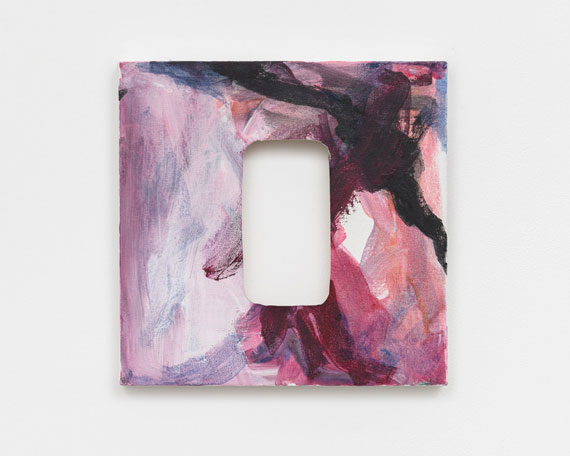
Image credit: Kim Gordon, He stood and felt the tone in the room change, 2023, watercolour and gouache on canvas, 30.5 x 30.5 cm. Courtesy the artist and 303 Gallery, New York
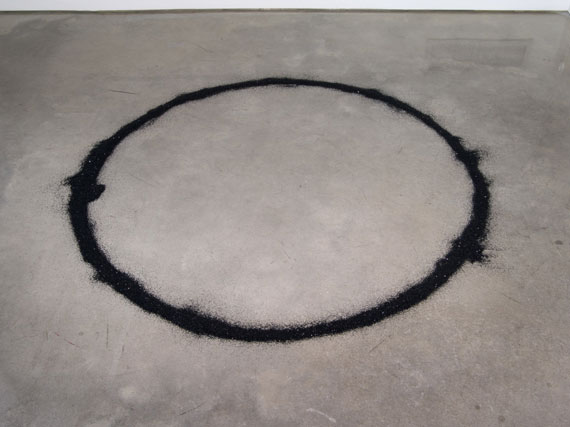
Image credit: Kim Gordon, Black Glitter Circle, 2008, Glitter, 66-inch diameter. Courtesy the artist and 303 Gallery, New York
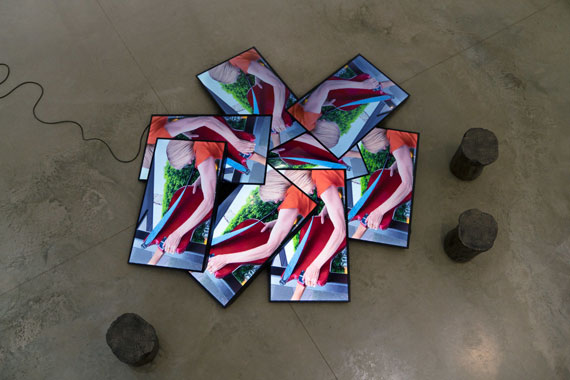
Image credit: Kim Gordon, Los Angeles June 6, 2019, one-channel video installation, (colour, sound), eight monitors, three resin stools, 16:06 minutes, Installation view, The Bonfire, 303 Gallery, New York, 2020. Courtesy the artist and 303 Gallery, New York
This article was originally published in VAULT Magazine Issue 45 (February 2024 – April 2024).
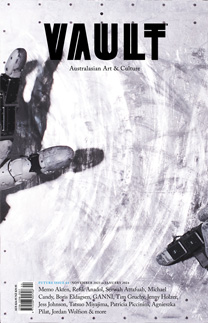
Click here to Subscribe





